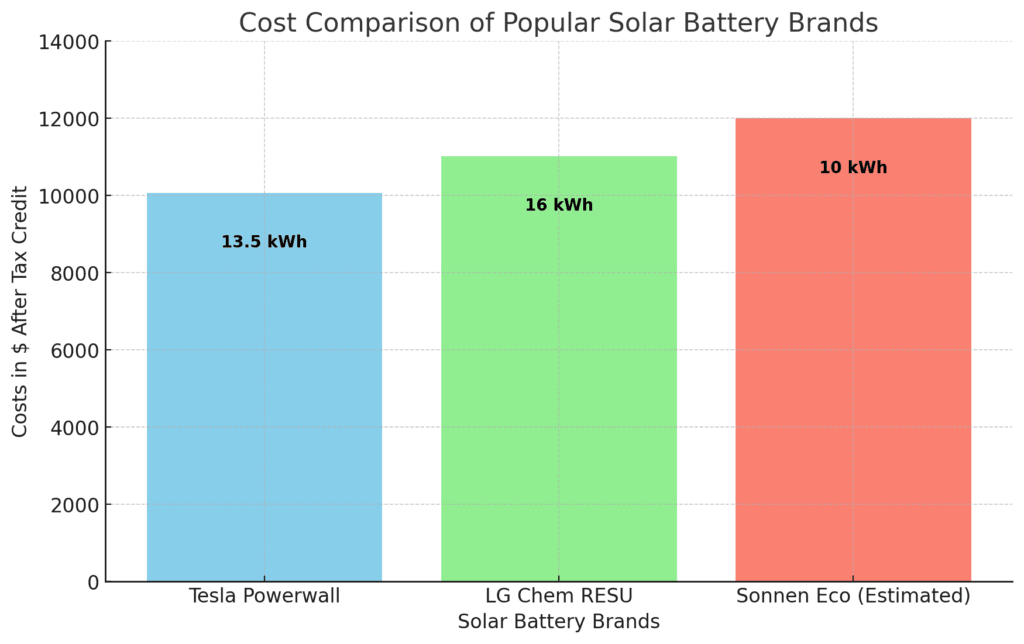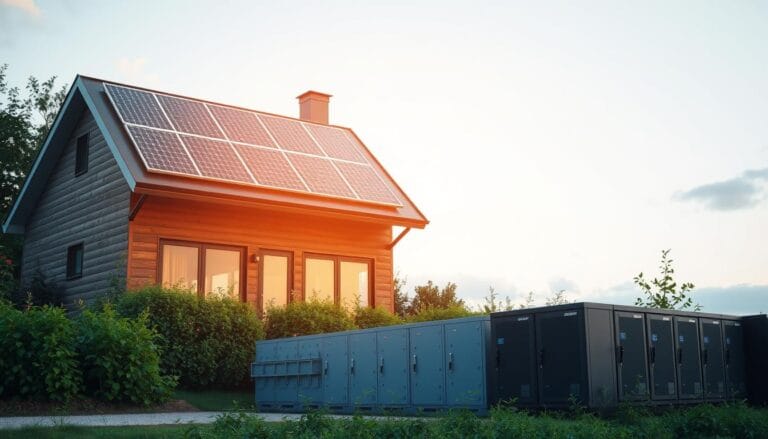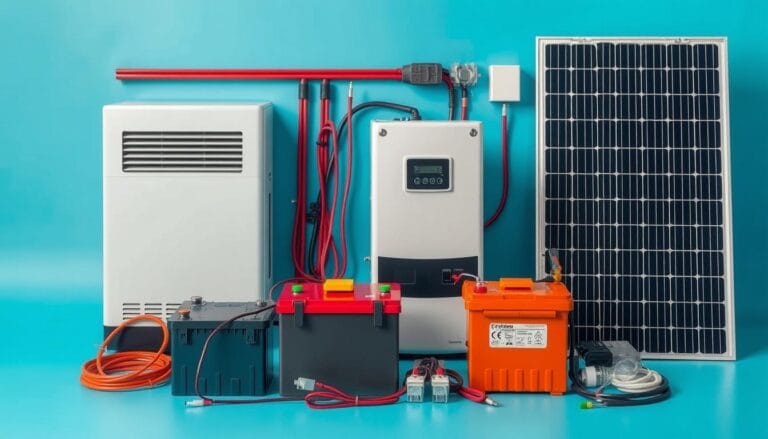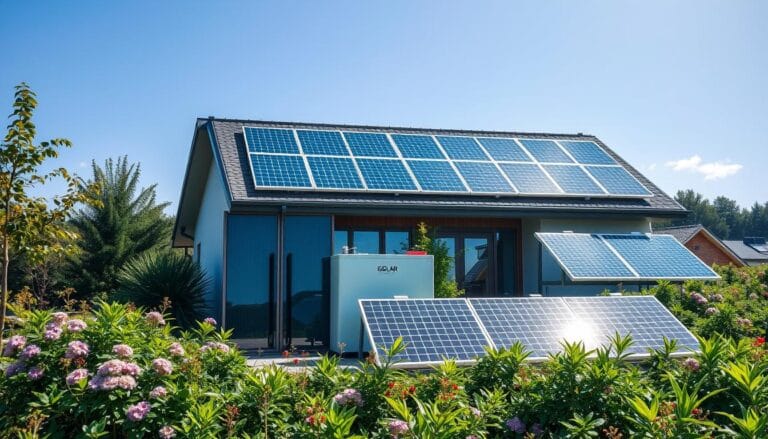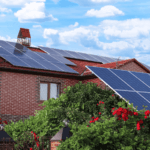More homeowners are turning to solar power as an alternative energy source. This means understanding the cost of solar battery storage is key. Solar batteries let you store extra energy from your solar panels for later. This ensures you have a steady power supply, even when the sun is hidden.
In this article, we’ll look at what affects the cost of solar batteries. We’ll also guide you in choosing the right residential solar battery system.
A typical home in 2024 needs about 10.1 kilowatt-hours (kWh) of battery storage for backup. After tax credits, this battery would cost around $8,944. But remember, solar batteries can make solar systems more expensive, sometimes doubling the total cost.
On average Solar Battery Cost, a complete solar system and battery can cost between $25,000 and $35,000. The price changes based on the system’s size and where you live.
Key Takeaways
- Solar batteries provide reliable energy storage for homes with solar panels
- Typical residential solar battery systems cost between $8,000 and $15,000
- Battery capacity, chemistry, and installation complexity affect overall cost
- Federal tax credits and local incentives can help offset solar battery expenses
- Assess your energy needs and goals to determine if a solar battery is worth the investment
The Benefits of Solar Batteries for Home Energy Storage
Solar batteries are getting more popular for homeowners who want to get the most from their solar panels. They store extra solar energy made during the day. This gives you a steady power source and cuts down on your need for the power grid. Let’s look at why adding solar batteries to your home is a smart move.
Increased Energy Independence
Solar batteries give you more control over your energy. With a solar battery backup system, you can save the extra energy your panels make during the day. Then, you can use it at night or when the power goes out. This way, you depend less on the utility company and save money on your energy bills.
Reduced Reliance on the Power Grid
Storing solar energy in batteries means you use less power from the grid. This is great for places where the power often goes out or is unreliable. With a full solar battery, you can keep your important devices on even when the grid fails. This gives you peace of mind and keeps your home running smoothly in emergencies.
Potential Savings on Electricity Bills
Solar batteries can also lower your electricity bills. By saving energy during sunny hours and using it when it costs more, you use less grid power. This is a big plus in areas with high energy prices or where net metering isn’t available.
The cost of solar batteries is high, between $12,000 to $20,000 on average. But, you can save money on your bills over time. The 30% federal tax credit for solar batteries can cut the cost by about $4,500.
| Battery Size (kWh) | Average Cost (before tax credit) | Average Cost (after 30% tax credit) |
|---|---|---|
| 6 | $7,200 | $5,040 |
| 10 | $12,000 | $8,400 |
| 14 | $16,800 | $11,760 |
| 18 | $21,600 | $15,120 |
As renewable energy battery technology gets better and solar energy storage costs go down, solar batteries will be even more attractive for homeowners. They will help make the most of solar energy and lessen dependence on the grid.
Factors Affecting Solar Battery Cost
When thinking about getting a solar battery system, it’s key to know what affects the cost. The type of battery and its size, the setup’s complexity, and local market conditions all play a big part in the final price. These factors help determine how much you’ll pay for your solar battery setup.
Battery Type and Chemistry
The cost of a solar battery setup is heavily influenced by the battery itself, especially its type and chemistry. Lithium-ion batteries are the top choice for storing home energy, with nickel manganese cobalt (NMC) and lithium iron phosphate (LFP) being the favorites. LFP batteries are pricier by 30-50% than NMC ones because they last longer and are safer. Batteries make up about half to two-thirds of the total cost of a solar storage system.
Battery Capacity and Power Output
The cost also depends on the battery’s capacity and power. Home batteries usually store 10 to 20 kWh of electricity and support up to 30 amps. Bigger batteries with more capacity or power cost more but offer more flexibility and energy independence for your home.
Installation Complexity and Labor Costs
How hard it is to install the battery and the labor costs can change based on the setup. Installing the battery with the solar panels can save time and money by doing all the electrical work at once. A typical home solar system’s cost includes labor (4.9%), office work (24.3%), and other expenses (22.5%).
Local Market Conditions and Incentives
Local market factors, like high battery demand or installer availability, can affect prices. Also, government and utility company incentives can cut the cost of solar batteries. For instance, the 30% federal tax credit can lower the price of solar batteries. In California, the Self-Generation Incentive Program (SGIP) offers $0.15 per watt-hour ($150 per kWh) of battery capacity, making the system cheaper.
| Factor | Impact on Cost |
|---|---|
| Battery Type and Chemistry | LFP batteries are 30-50% more expensive than NMC batteries |
| Battery Capacity and Power Output | Higher capacity and power output may result in higher costs |
| Installation Complexity and Labor Costs | Retrofitting an existing system may result in higher labor costs |
| Local Market Conditions and Incentives | High demand or limited availability of installers can increase prices, while incentives can reduce overall costs |
Average Solar Battery Cost for Residential Installations
When looking into residential solar battery systems, homeowners might spend between $8,000 to $16,000 before tax credits. Solar batteries alone can cost $6,000 to $13,000 or more. This depends on the battery’s capacity, brand, and type.
Here’s a look at solar battery costs for different home sizes before tax credits:
- Homes under 1,000 square feet: $5,300 – $13,000
- Homes between 1,000 and 1,500 square feet: $9,000 – $20,000
- Homes between 1,500 and 2,000 square feet: $10,000 – $23,000
- Homes larger than 2,000 square feet: $13,500 – $26,000
Solar battery prices also depend on their energy storage capacity. Here are the unit prices:
| Battery Capacity | Price Range |
|---|---|
| 3 kWh – 4 kWh | $3,000 – $5,000 |
| 5 kWh – 7 kWh | $3,300 – $10,000 |
| 8 kWh – 11 kWh | $7,000 – $17,000 |
| 12 kWh – 17 kWh | $8,000 – $20,000 |
| 18 kWh – 25 kWh | $11,500 – $23,000 |
| Greater than 25 kWh | $17,500 – $40,000+ |
The total cost for a solar panel and battery setup is about $16,200 to $37,700 after the 30% federal tax credit. Labor costs for solar battery installations are usually $2,000 to $3,000. Extra costs like hiring electricians, new wiring, and panel upgrades also add to the total cost.
On average, homeowners pay around $10,000 for solar battery systems for their homes. Solar batteries can range from $300 to $30,000. Most people spend between $6,000 and $11,000 for their energy storage needs.
Comparing Costs of Popular Solar Battery Brands
Looking into residential solar battery solutions means comparing costs of popular brands. This helps you find the best fit for your energy needs and budget. Four top brands stand out: Tesla Powerwall, LG Chem RESU, Sonnen Eco, and Enphase Encharge. Each offers unique features and prices.
Tesla Powerwall
Tesla Powerwall is a top name in solar batteries, known for its sleek design and advanced features. A 13.5 kWh Tesla Powerwall battery costs about $10,064 after the federal tax credit. This makes it a more affordable choice. The Tesla Powerwall 3 got a high score of 7.4 out of 10 in CNET’s review, making it the best all-around battery.
LG Chem RESU
LG Energy Solution offers some of the most budget-friendly solar batteries. Prices average about $984/kWh. A 16 kWh LG Chem RESU battery costs around $11,021 after the tax credit. This is a cost-effective option for homeowners wanting off-grid solar batteries or solar battery backup systems.
Sonnen Eco
Sonnen Eco is a popular choice for home solar battery systems. Prices vary by model and capacity. For Sonnen Eco, getting a personalized quote from a local installer is key to know the total solar battery installation costs for your needs.
Enphase Encharge
Enphase Encharge is a modular system that grows with your energy needs. A 10.08 kWh Enphase Encharge battery costs about $9,878 after the tax credit, with a price of around $1,400/kWh. The Enphase IQ Battery 5P scored 7.3 out of 10 in CNET’s review, making it the best for smaller needs.
| Brand | Battery Capacity (kWh) | Price After Federal Tax Credit | Price per kWh |
|---|---|---|---|
| Tesla Powerwall | 13.5 | $10,064 | $746 |
| LG Chem RESU | 16 | $11,021 | $984 |
| Enphase Encharge | 10.08 | $9,878 | $1,400 |
When looking at solar battery costs, consider more than just the upfront price. Think about battery capacity, power output, and how it fits with your solar setup. By comparing these factors, you can choose the best solar battery for your home.
Solar Battery Cost by Region and State
When looking into solar power for your home, it’s key to know that the cost of solar batteries changes a lot by region and state. Things like the installer’s experience, local labor costs, and the battery brands used affect the price. Also, the best battery size for your home can change based on the weather, energy laws, and how much power you use in your area. These factors can change the total cost of storing solar energy.
EnergySage shows that Oregon has the highest costs for battery installations, while California has the lowest. For instance, in Arizona, the average cost for a solar battery is $1,206 per kWh. With a 10.1 kWh battery, the total cost after the tax credit for renewable energy is $8,526. Oregon, on the other hand, has a median price of $1,638/kWh and a typical 15 kWh battery size. This makes the total cost after the tax credit $17,199.
Here’s a table to show how solar battery costs differ across states:
| State | Median Price per kWh | Typical Battery Size (kWh) | Total Installed Cost (After Tax Credit) |
|---|---|---|---|
| Arizona | $1,206 | 10.1 | $8,526 |
| California | $1,104 | 12.8 | $9,882 |
| Colorado | $1,314 | 11.5 | $10,565 |
| Florida | $1,188 | 13.2 | $10,962 |
| Massachusetts | $1,422 | 12.1 | $12,021 |
| New Jersey | $1,377 | 13.6 | $13,083 |
| Oregon | $1,638 | 15.0 | $17,199 |
These costs are averages, and actual prices can change based on the battery type and installation details. Homeowners should think about their energy needs and talk to local solar installers. This way, they can find the best and most affordable solar battery solution for their home.
Financial Incentives and Rebates for Solar Battery Installations
Looking into solar battery systems? It’s key to check out the financial help and rebates out there. These can cut down the cost of adding solar battery storage to your home. You’ll find everything from federal tax credits to state and local savings to make it cheaper.
Federal Tax Credit
The Inflation Reduction Act of 2022 boosted solar battery financing. Homeowners can get a 30% tax credit for solar batteries. This means a $10,000 system could get a $3,000 tax break, lowering the cost a lot.
State and Local Incentives
Many states and local areas have their own solar rebates and incentives. These can be added to the federal tax credit, making solar batteries even more affordable. For example, New York offers up to $0.30 per watt for solar setups through the NY-Sun Megawatt Block Program.
New York also has a tax credit for solar systems on primary homes, covering 25% of costs, up to $5,000. California has the Self-Generation Incentive Program, cutting the cost of batteries. In New York, the Retail Energy Storage Program gives $250 per kWh, saving homeowners $2,300 to $3,300 on average.
Utility Company Programs
Utility companies are now supporting solar battery installations with their own incentives. They pay homeowners for using their battery energy when it’s needed most. This helps save money and keeps the grid stable.
Commercial customers in New York City and other areas can get rebates from NYSERDA’s Retail Storage Incentive program. The rebate depends on the battery size and location, and it’s based on what’s available.
| Incentive Program | Description | Benefit |
|---|---|---|
| Federal Tax Credit | 30% tax credit for solar battery installations | Reduces overall cost by $3,000 for a $10,000 battery |
| NY-Sun Megawatt Block Program | $0.20/W in Con Edison area, $0.30/W in upstate NY | Lowers upfront cost of solar installations |
| NY State Solar Equipment Tax Credit | 25% of solar system costs, up to $5,000 | Significant savings for homeowners |
| Retail Energy Storage Program (NY) | $250 per kWh of solar battery capacity | $2,300 to $3,300 in savings for average battery |
Using these solar battery financing options and incentives can make the upfront costs much lower. Add in the savings on electricity bills and the chance for more energy independence. Investing in solar batteries is a smart choice for those wanting to improve their home energy setup.
Is a Solar Battery Worth the Investment?
Buying a solar power battery for your home has many benefits. It can make you less dependent on the power grid, save you money on electricity, and increase your energy independence. But, deciding if it’s a good investment depends on your energy needs, goals, and the system’s cost.
Assessing Your Energy Needs and Goals
Before getting a solar battery, think about your home’s energy needs and goals. If your area often has power outages or you want to use more renewable energy, a solar battery could be a good choice. These systems can keep your power on during emergencies when the grid fails, keeping you safe and comfortable.
Experts say most homes should get solar batteries for just the essential loads because they’re expensive. But, if you want to be fully off-grid, you might need a bigger battery.
Calculating the Return on Investment (ROI)
To see if a solar battery is a good buy, figure out the return on investment (ROI). Compare the battery’s cost with the savings on your electricity bills over its life. A 9.8 kWh solar battery costs about $11,100 after incentives, which is a big upfront cost.
But, solar batteries can save you money if your utility doesn’t offer full-retail net metering or if you’re on time-of-use rates. Prices for lithium-ion batteries fell by 87% from 2010 to 2019, making them cheaper. Plus, the federal investment tax credit (ITC) lets homeowners claim up to 26% of battery costs, saving about $4,000 for the average system.
Considering Net Metering Policies and Utility Rates
Net metering policies affect how valuable a solar battery is. If your utility offers full-retail net metering, a battery might not save you more money. But, if you don’t have net metering or your utility pays less for excess energy, a battery can help you use your own power better.
Solar battery storage systems work with net metering. They let you send extra electricity to the grid and use it for free later. This mix of reliable backup power and saving money makes solar batteries more appealing.
Factors to Consider When Choosing a Solar Battery
When picking eco-friendly batteries, think about a few key things to find the best one for your home. Lithium-ion batteries, especially lithium iron phosphate (LFP), are great for homes. They’re efficient, last a long time, and are safe. But, they cost more than other types like lead-acid batteries.
The size of a solar battery, in kilowatt-hours (kWh), shows how much electricity it can store. This affects how well it meets your energy needs. For instance, the FranklinWH system can store 13.6 kWh per battery, up to 204 kWh with an intelligent controller. To figure out how much you need, use this formula: Battery storage capacity = Total Daily Energy Consumption / (DoD x Days of Autonomy).
Power output, in kilowatts (kW), is also key when choosing green energy batteries. Pick a power output that fits your energy use and the devices you want to power during outages. A bigger capacity and output means more reliable backup power but costs more.
The depth of discharge (DoD) tells you how much of the battery’s capacity you can safely use. A higher DoD means more usable energy but costs more. Round-trip efficiency, which is how much energy you can get back from the battery, is also crucial. Better efficiency means better performance and sustainable battery costs.
| Battery Type | Lifespan | Cost Range |
|---|---|---|
| Lithium-ion | 10-15 years | $7,000-$15,000 |
| Lead-acid | 5-7 years | $5,000-$10,000 |
When looking at solar batteries, think about their cycle life and how they fit with your renewable energy plans. Things like temperature, depth of discharge, and charging cycles affect their life and performance. Choosing the right solar battery with smart features like inverters and energy monitoring can make your system more efficient. This leads to better green energy battery outlays.
By considering these factors and matching them with your energy needs and goals, you can pick the best solar battery for your home. The right battery will make your home more energy independent, cut down on grid reliance, and help the planet with eco-friendly battery purchases and sustainable battery costs.
The Future of Solar Battery Technology and Costs
The world is moving towards a sustainable future, increasing the need for renewable energy and efficient storage. Solar batteries are key in this shift, letting homeowners store solar energy for later use and cut down on grid reliance. As technology improves and costs drop, solar batteries will become more affordable and effective.
Advancements in Battery Chemistry and Efficiency
Researchers and makers are always working to make battery chemistry and efficiency better. Lithium-ion batteries, the top choice now, have gotten much better in recent years. New solid-state electrolytes and cathode materials are on the horizon, promising more energy, quicker charging, and better safety. These changes will lead to smaller, more efficient solar batteries, making them more appealing to homeowners.
New technologies like flow batteries and sodium-ion batteries could offer cheaper options in the future. These could provide affordable storage for homes and businesses. As they grow, they might cut the cost of solar batteries and speed up their use.
Projected Cost Reductions in the Coming Years
Solar battery costs have dropped a lot in the last few years, thanks to tech advances and making more batteries. Lithium-ion batteries have seen a 90% price drop in 15 years. This trend is set to keep going, with prices expected to fall by 40% by 2030.
| Year | Projected Cost Reduction | Key Factors |
|---|---|---|
| 2025 | 20-25% | Improved manufacturing processes, increased production scale |
| 2030 | 35-40% | Advancements in battery chemistry, economies of scale |
| 2035 | 45-50% | Breakthroughs in battery technology, widespread adoption |
As battery production grows and making them becomes more efficient, the solar battery cost will drop a lot. This, along with more renewable energy use, will make solar energy storage costs cheaper for homeowners. Governments and groups worldwide are setting big goals for renewable energy, pushing demand for renewable energy battery technology and lowering costs.
With expected cost cuts and tech improvements, homeowners can look forward to cheaper, better energy storage soon. As we move to a cleaner energy future, solar batteries will be key in powering our homes and communities.
Conclusion
Solar battery cost is a big factor for homeowners looking into solar energy storage. These systems bring many benefits like more energy control and lower electricity bills. But, the initial cost of installing solar batteries can be high.
The price of solar batteries varies widely, from $5,000 to $15,000. This depends on the type of battery, its size, and the local market. Yet, there are ways to reduce the cost.
Financial incentives like the federal tax credit and state rebates can cut down the initial cost. As battery technology gets better and production grows, solar batteries will likely become cheaper. This will make them more affordable for more people.
Before getting a solar battery system, think about your energy needs and how much you can save. Compare the upfront costs with the long-term benefits. By doing this and using available incentives, homeowners can make smart choices. They can move towards a greener and more independent energy future.



